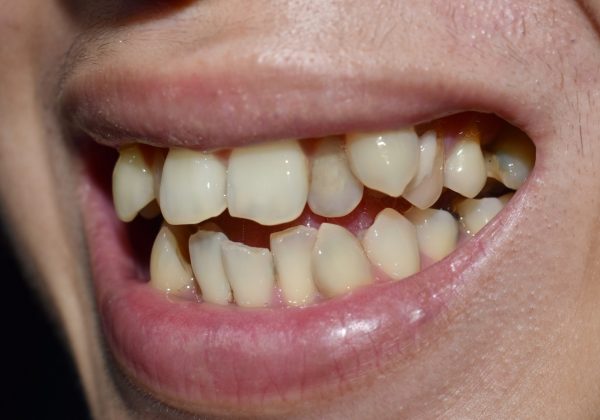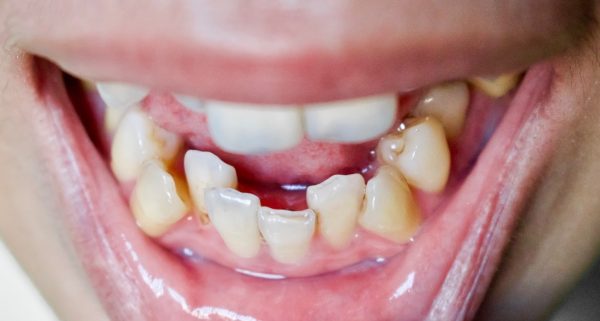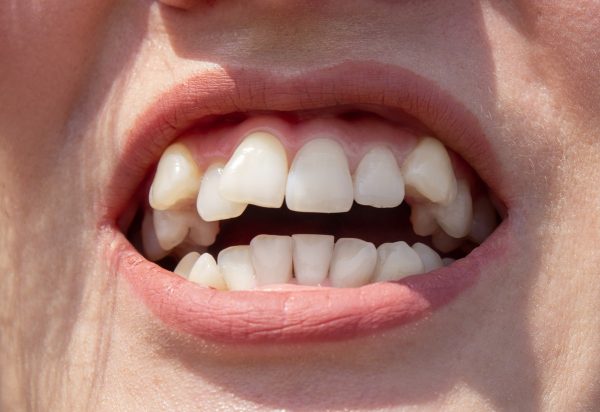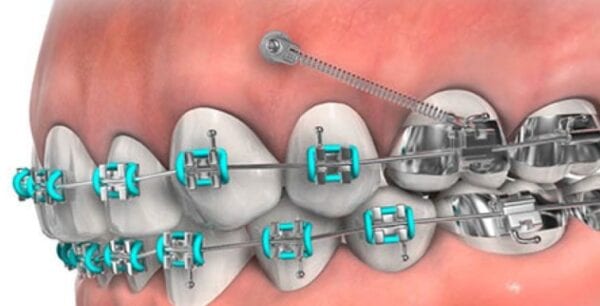Intrusion
Definition: Intrusion is the vertical movement of a tooth into (towards) the jawbone. So, for upper teeth, it is an upward movement. For lower teeth, it is a downward movement. It is used to correct teeth that are positioned too “high” (in the lower jaw) or too “low” (in the upper jaw) compared to the rest of the dental arch.
Applications: This movement is often applied in cases where a tooth has erupted too far out of the gum line or in situations of excessive wear that has made the tooth appear too long. Intrusion can help in reducing gum line discrepancies, correcting deep overbites, and managing cases where the vertical height of the teeth needs to be decreased for restorative procedures.
Methods: Orthodontic intrusion can be achieved using self-ligating braces, clear aligners like Invisalign, or with the aid of mini screws (temporary anchorage devices, TADs) that provide a fixed point from which to apply force.

Extrusion
Definition: Extrusion describes a vertical movement of a tooth out of the jawbone. It is used to correct teeth that are positioned too “low” (in the lower jaw) or too “high” (in the upper jaw) or have not erupted fully.
Applications: Extrusion is commonly used for teeth that are partially erupted, impacted, or have suffered trauma leading to intrusion (being pushed into the jawbone). It can also aid in leveling and evening out the gum line for both esthetic and functional improvements, such as improving the contact between opposing teeth.
Methods: Like intrusion, extrusion can be accomplished with various orthodontic appliances, including self-ligating braces and clear aligners. The use of elastics or springs, often in conjunction with brackets or aligners, applies gentle force to gradually move the tooth to its correct position.
Both intrusion and extrusion require careful planning and execution by Dr. Ryan Redford of Burke & Redford Orthodontists to ensure the movements are controlled and minimize any potential risks, such as root resorption or adverse effects on the surrounding bone and gum tissue. These techniques are integral components of comprehensive orthodontic treatment plans aimed at achieving optimal occlusion, function, and esthetics.

Malocclusions Addressed by Intrusion
Intrusion is the movement of a tooth into the alveolar bone. It is primarily indicated in the following conditions:
Deep Bite (Overbite): An overbite, alternatively termed a deep bite, describes an orthodontic scenario characterized by an excessive vertical overlap of the upper and lower front teeth. This scenario often manifests when the lower front teeth have erupted too far vertically upwards, often concealing a significant portion of them when the mouth is closed.
Distinct from the normal overlap that facilitates chewing and speaking, a deep bite extends beyond the usual boundaries, potentially leading to a range of oral health concerns and esthetic issues. Intrusion of the over-erupted anterior teeth can help reduce the overbite, improving the bite’s function and esthetic appearance.
Open Bite: In cases where back teeth over-erupted, contributing to an anterior open bite (where front teeth do not touch/overlap when the back teeth are biting together), intrusion can help correct the bite. This is done by moving the back teeth vertically towards their respective jaw base which allows the lower jaw to hinge closed more when biting down. This additional hinging closed of the jaw results in more vertical overlap of the front teeth, correcting the open bite.
Traumatic Occlusion: Over-erupted teeth can cause traumatic occlusion, leading to excessive wear or trauma on opposing teeth or soft tissues. Intrusion helps alleviate these issues by repositioning the teeth to a more harmonious occlusal plane.
Malocclusions Addressed by Extrusion
Extrusion involves the vertical movement of a tooth out of the alveolar bone and is commonly applied in:
Partial Eruption or Impaction: Teeth that have not fully erupted or are impacted (stuck in the bone or gum tissue) can cause bite issues and esthetic concerns. Extrusion is used to bring these teeth into proper alignment within the dental arch.
Tooth Intrusion Due to Trauma: Teeth that have been pushed into the alveolar bone due to trauma may require extrusion to return them to their correct position in the dental arch.
Subgingival Fractures or Caries: Teeth with fractures or caries extending below the gum line may need extrusion to expose sufficient tooth structure above the gum line for restorative treatment.
Esthetic Correction: Extrusion may be employed to correct uneven gum margins or to improve the appearance of teeth that appear too short in relation to the overall smile.

Considerations and Treatment Planning
Both intrusion and extrusion require meticulous planning to ensure that the movement does not adversely affect the tooth’s health or the surrounding periodontal (gum tissue and bone) structures. Potential risks such as root resorption, loss of vitality, or periodontal pocket formation must be carefully evaluated.
Dr. Redford will recommend the type of treatment to correct the malocclusion, which could include self-ligating braces (Damon system, clear ceramic, metal, or TAD’s) and the force will depend on the specific patient’s orthodontic requirements.
The selection of treatment method (including self-ligating braces, clear aligners like Invisalign, or temporary anchorage devices) and the level of force used are tailored based on the unique clinical situation and the specific requirements of each patient.
A Temporary Anchorage Device (TAD) is a small, biocompatible device made from titanium or a titanium alloy, used in orthodontics to provide a fixed point from which to apply force to move teeth. TADs are utilized to enhance orthodontic treatment by facilitating complex tooth movements that might be difficult or impossible to achieve with braces or aligners alone. Here’s a brief overview with a bulleted list:
Temporary Anchorage Device (TAD)
Purpose: To provide a temporary fixed anchor point in the mouth.
Material: Made from titanium or a titanium alloy for biocompatibility.
Placement: Inserted into the jawbone or gum tissue at strategic locations.
Usage: Supports the movement of specific teeth into desired positions without putting unwanted pressure (and unwanted side effect movements) on adjacent teeth.
Versatility: Can be used for various orthodontic movements including intrusion, extrusion, closing spaces, and correcting bites.
Removability: Designed to be removed once the desired orthodontic movement has been achieved. These are different from dental implants used to replace missing teeth that “fuse” to the surrounding bone.

Benefits:
– Enhances the effectiveness of orthodontic treatment.
– Reduces treatment time in some cases.
– Increases the range of orthodontic issues that can be addressed.
– Offers a minimally invasive option to support difficult tooth movements.
The successful management of malocclusions with intrusion and extrusion movements significantly enhances orthodontic outcomes. By addressing vertical discrepancies, orthodontists can achieve a balanced and functional occlusion and improve the patient’s facial esthetics.
These treatments underscore the importance of a comprehensive orthodontic assessment and a customized treatment approach, as provided by skilled professionals in the field.
Patients Trust Burke & Redford Orthodontists in the Inland Empire
Dr. Redford will make the best recommendation for your child or teenager by providing the correct treatment plan to treat intrusion or extrusion when you Request a Consultation by calling our office during business hours, Monday through Thursday.
Here are our contact details for your convenience:
Address: 41238 Margarita Rd Ste 101, Temecula, CA 92591
Phone: (951) 699-8011
Office Hours: M-F 9:00 a.m. – 5:00 p.m.
Lake Elsinore Orthodontist Office
Address: 351 Railroad Canyon Rd Ste C, Lake Elsinore, CA 92532
Phone: (951) 699-8011
Office Hours: Open 1st and 3rd Wednesdays 1:00 p.m. – 5:00 p.m.